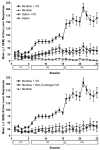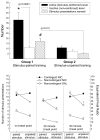The role of nicotine in smoking: a dual-reinforcement model
- PMID: 19013940
- PMCID: PMC2694565
- DOI: 10.1007/978-0-387-78748-0_6
The role of nicotine in smoking: a dual-reinforcement model
Abstract
Models of intravenous nicotine self-administration in laboratory animals are being used to investigate the behavioral and neurobiological consequences of nicotine reinforcement, and to aid in the development of novel pharmacotherapies for smoking cessation. Central to these models is the principle of primary reinforcement, which posits that response-contingent presentation of a primary reinforcer, nicotine, engenders robust operant behavior, whereas response-independent drug delivery does not. This dictum of nicotine as a primary reinforcer has been widely used to explain why people smoke tobacco-smoking results in the rapid delivery of nicotine to the brain, setting up a cascade of neurobiological processes that strengthen subsequent smoking behavior. However, there is mounting evidence that the primary reinforcement model of nicotine self-administration fails to fully explain existing data from both the animal self-administration and human smoking literatures. We have recently proposed a "dual reinforcement" model to more fully capture the relationship between nicotine and self-administration, including smoking. Briefly, the "dual reinforcement" model posits that nicotine acts as both a primary reinforcer and a reinforcement enhancer. The latter action of nicotine had originally been uncovered by showing that a reinforcing VS, which accompanies nicotine delivery, synergizes with nicotine in the acquisition and maintenance of self-administration, and that this synergism can be reproduced by combining operant responding for the reinforcing stimulus with non-contingent (response-independent) nicotine. Thus, self-administration (and smoking) is sustained by three actions: (1) nicotine, acting as a primary reinforcer, can sustain behavior that leads to its delivery; (2) nicotine, acting as a primary reinforcer, can establish neutral environmental stimuli as conditioned reinforcers through Pavlovian associations; and (3) nicotine, acting as a reinforcement enhancer, can magnify the incentive value of accompanying stimuli, be they conditioned or unconditioned reinforcers.
Figures





References
-
- Arroyo M, Markou A, Robbins TW, Everitt BJ. Acquisition, maintenance and reinstatement of intravenous cocaine self-administration under a second-order schedule of reinforcement in rats: effects of conditioned cues and continuous access to cocaine. Psychopharmacology (Berl) 1998;140(3):331–344. - PubMed
-
- Balfour DJ, Wright AE, Benwell ME, Birrell CE. The putative role of extra-synaptic mesolimbic dopamine in the neurobiology of nicotine dependence. Behav Brain Res. 2000;113(12):73–83. - PubMed
-
- Bevins RA, Palmatier MI. Extending the role of associative learning processes in nicotine addiction. Behavioral and Cognitive Neuroscience Review. 2004;3:143–158. - PubMed
-
- Bozarth MA, Murray A, Wise RA. Influence of housing conditions on the acquisition of intravenous heroin and cocaine self-administration in rats. Pharmacol Biochem Behav. 1989;33(4):903–907. - PubMed
-
- Brunzell DH, Chang JR, Schneider B, Olausson P, Taylor JR, Picciotto MR. beta2-Subunit-containing nicotinic acetylcholine receptors are involved in nicotine-induced increases in conditioned reinforcement but not progressive ratio responding for food in C57BL/6 mice. Psychopharmacology (Berl) 2006;184(34):328–338. - PubMed
Publication types
MeSH terms
Substances
Grants and funding
LinkOut - more resources
Full Text Sources
